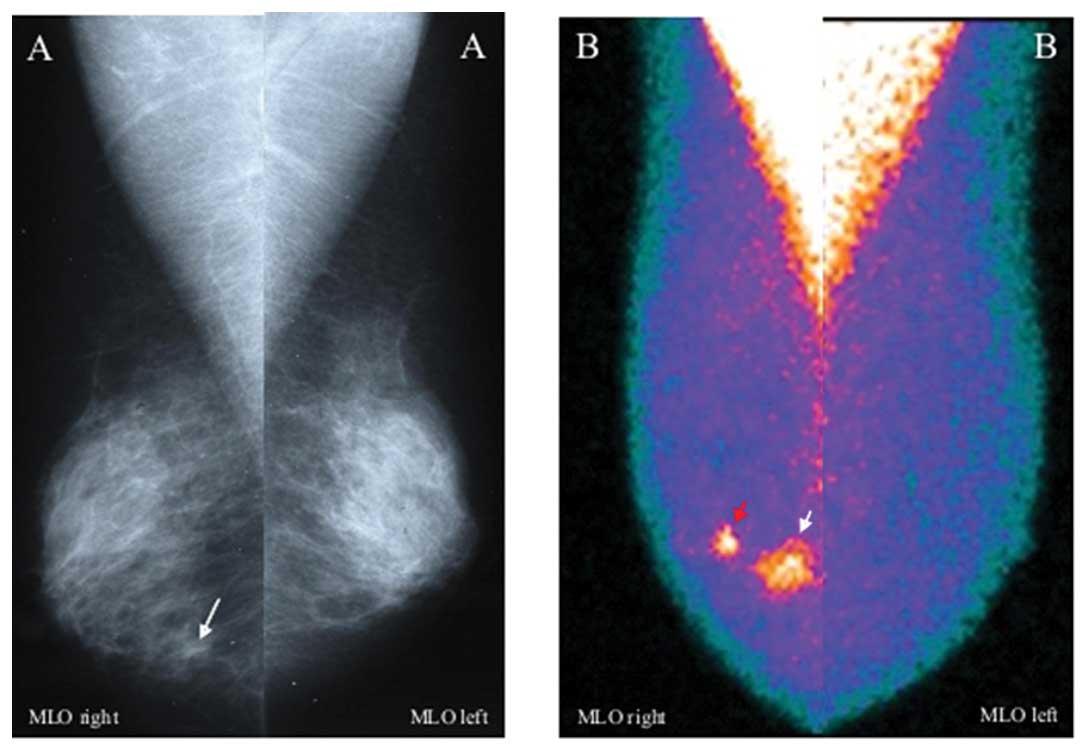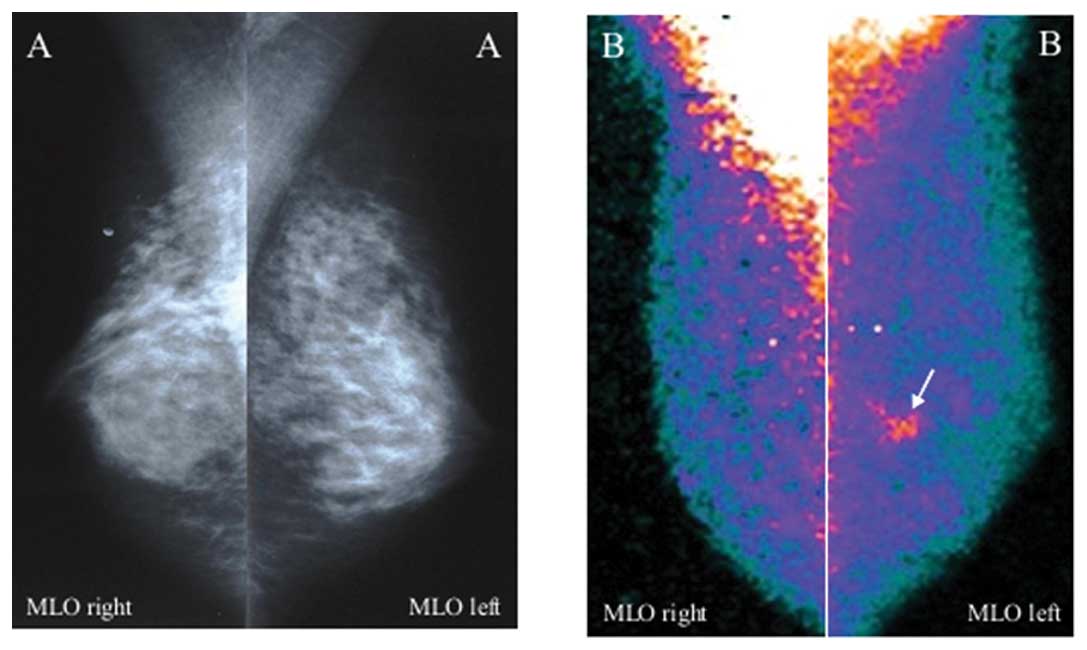|
1
|
Kolb TM, Lichy J and Newhouse JH:
Comparison of the performance of screening mammography, physical
examination, and breast US and evaluation of factors that influence
them: an analysis of 27,825 patient evaluations. Radiology.
225:165–175. 2002. View Article : Google Scholar : PubMed/NCBI
|
|
2
|
Lagios MD, Westdahal PR and Rose MR: The
concept and implications of multicentricity in breast carcinoma.
Pathology Annula. Sommers S and Rosen P: Appleton-Century-Crofts;
New York, NY: 1981, PubMed/NCBI
|
|
3
|
Holland R, Veling SHJ, Mravunac M and
Hendriks JHCL: Histologic multifocality of Tis, T1-2 breast
carcinomas: implications for clinical trials of breast-conserving
surgery. Cancer. 56:979–990. 1985. View Article : Google Scholar : PubMed/NCBI
|
|
4
|
Liberman M, Sampalis F, Mulder DS and
Sampalis JS: Breast cancer diagnosis by scintimammography: a
meta-analysis and review of the literature. Breast Cancer Res
Treat. 80:115–126. 2003. View Article : Google Scholar : PubMed/NCBI
|
|
5
|
Howarth D, Sillar R, Clark D and Lan L:
Technetium-99m sestamibi scintimammography: the influence of
histopathological characteristics, lesion size and the presence of
carcinoma in situ in the detection of breast carcinoma. Eur J Nucl
Med. 26:1475–1481. 1999. View Article : Google Scholar
|
|
6
|
Khalkhali I, Villanueva-Meyer J, Edell SL,
Connolly JL, Schnitt SJ, Baum JK, Houlihan MJ, Jenkins RM and Haber
SB: Diagnostic accuracy of 99mTc-Sestamibi breast
imaging: multicenter trial results. J Nucl Med. 41:1973–1979.
2000.
|
|
7
|
Goldsmith SJ, Parson W, Guiberteau MJ,
Stern LH, Lanzkowsky L, Weigert J, Heston TF, Jones E, Buscombe J
and Stabin MG: SNM practice guideline for breast scintigraphy with
breast specific γ-cameras 1.0. J Nucl Med Technol. 38:219–224.
2010.PubMed/NCBI
|
|
8
|
Rhodes DJ, O’Connor MK, Phillips SW, Smith
RL and Collins DA: Molecular breast imaging: a new technique using
technetiumTc scintimammography to detect small tumors of the
breast. Mayo Clin Proc. 80:24–30. 2005. View Article : Google Scholar : PubMed/NCBI
|
|
9
|
Spanu A, Cottu P, Manca A, Chessa F, Sanna
D and Madeddu G: Scintimammography with dedicated breast camera in
unifocal and multifocal/multicentric primary breast cancer
detection: a comparative study with SPECT. Int J Oncol. 31:369–377.
2007.PubMed/NCBI
|
|
10
|
Spanu A, Chessa F, Meloni GB, Sanna D,
Cottu P, Manca A, Nuvoli S and Madeddu G: The role of planar
scintimamography with high-resolution dedicated breast camera in
the diagnosis of primary breast cancer. Clin Nucl Med. 33:739–742.
2008. View Article : Google Scholar : PubMed/NCBI
|
|
11
|
D’Orsi CJ and Kopans DB: Mammographic
features analysis. Semin Roentgenol. 18:204–230. 1993.
|
|
12
|
Pediconi F, Catalano C, Padula S, Roselli
A, Moriconi E, Pronio AM, Kirchin MA and Passariello R:
Contrast-enhanced magnetic resonance mammography: does it affect
surgical decision-making in patients with breast cancer? Breast
Cancer Res Treat. 106:65–74. 2007. View Article : Google Scholar : PubMed/NCBI
|
|
13
|
Drew PJ, Chatterjee S, Turnbull LW, Read
J, Carleton PJ, Fox JN, Monson JR and Kerin MJ: Dynamic contrast
enhanced magnetic resonance imaging of the breasts is superior to
triple assessment for the pre-operative detection of multifocal
breast cancer. Ann Surg Oncol. 6:599–603. 1999. View Article : Google Scholar : PubMed/NCBI
|
|
14
|
Houssami N and Hayes DF: Review of
preoperative magnetic resonance imaging (MRI) in breast cancer:
should MRI be performed on all women with newly diagnosed, early
stage breast cancer? CA Cancer J Clin. 59:290–302. 2009. View Article : Google Scholar : PubMed/NCBI
|
|
15
|
Saslow D, Boetes C, Burke W, Harms S,
Leach MO, Lehman CD, Morris E, Pisano E, Schnall M, Sener S, Smith
RA, Warner E, Yaffe M, Andrew KS and Russel CA: American Cancer
Society guidelines for breast screening with MRI as an adjunct to
mammography. CA Cancer J Clin. 57:75–89. 2007. View Article : Google Scholar : PubMed/NCBI
|
|
16
|
Brem RF, Schoonjans JM, Kieper DA,
Majewski S, Goodman S and Civelek C: High-resolution
scintimammography: a pilot study. J Nucl Med. 43:909–915.
2002.PubMed/NCBI
|
|
17
|
Brem RF, Petrovitch I, Rapelyea JA, Young
H, Teal C and Kelly T: Breast-specific gamma camera imaging with
99mTc-sestamibi and magnetic resonance imaging in the
diagnosis of breast cancer: a comparative study. Breast J.
13:465–469. 2007.PubMed/NCBI
|
|
18
|
Spanu A, Chessa F, Sanna D, Meloni GB,
Sanna D, Cottu P, Nuvoli S and Madeddu G:
99mTc-tetrofosmin Molecular Breast Imaging (MBI) with
high resolution dedicated breast camera (DBC) and breast dynamic
Magnetic Resonance Imaging (MRI) in the preoperative staging of
breast cancer: a comparative study. Eur J Nucl Med Mol Imaging.
36(Suppl. 2): S4712009.
|
|
19
|
Berg WA, Weinberg IN, Narayanan D, Lobrano
ME, Ross E, Amodei L, Tafra L, Adler LP, Uddo J, Stein W III and
Levine EA: High-resolution fluorodeoxyglucose positron emission
tomography with compression (positron emission mammography) is
highly accurate in depicting primary breast cancer. Breast J.
12:309–323. 2006. View Article : Google Scholar
|
|
20
|
Schilling K, Narayanan D, Kalinyak JE, The
J, Velasquez MV, Kahn S, Saady M, Mahal R and Chrystal L: Positron
emission mammography in breast cancer presurgical planning:
comparison with magnetic resonance imaging. Eur J Nucl Med Mol
Imaging. 38:23–36. 2011. View Article : Google Scholar : PubMed/NCBI
|

















